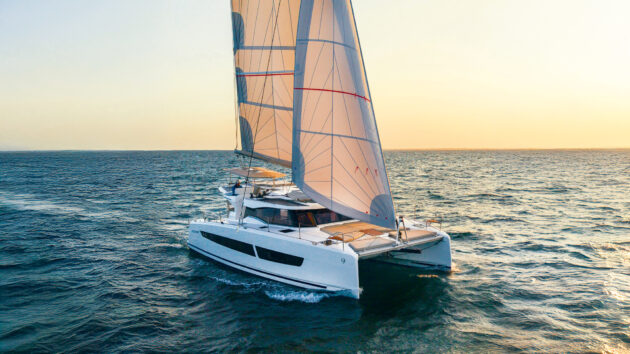These Fountaine Pajot 41 and 44 sisterships share DNA and design intent, so what does an extra 3ft in length deliver? And how much better are they than earlier models?
Double catamaran review: Fountaine Pajot 41 and Fountaine Pajot 44 tested
Continued development and refinement are key drivers behind the ever-increasing popularity of cruising catamarans. The scale of the rate of change in these boats was brought home to me when I stepped on board a Fountaine Pajot Bahia 46 built in 2004.
These were very desirable and well-regarded designs in their day, yet the extent to which internal volumes and the blending of indoor and outdoor living spaces have advanced over the intervening two decades on the best of today’s models is nothing short of astounding.
Today’s designs are a lot heavier than the older model and have proportionately smaller sail areas. Yet sailing performance remains remarkably good for vessels that offer so much accommodation, and newer models therefore still have potential to cover significant distances in respectable times.
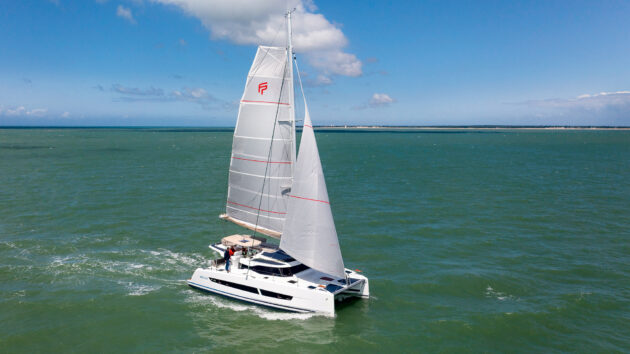
The Fountaine Pajot 41. Photo: Jean-Marie Liot/Fountaine Pajot
Solid and smooth
I was lucky to sail both of the new Fountaine Pajot models in a blustery 15-25 knots of onshore breeze, with occasional stronger gusts, in a brief interlude between heatwaves. With one reef in the mainsail, both boats felt very solid. Even upwind on the smaller boat there was no slamming of waves under the bridgedeck, though the sea state hadn’t had time to build to its full extent.
Upwind we sailed quite wide angles, often with a 55°-60° true wind angle, which produced respectable speeds. The smaller Fountaine Pajot 41 consistently made a shade over 7 knots in these conditions, while the Fountaine Pajot 44 was around half a knot faster on average. Unsurprisingly, both boats lose speed very quickly if you try to pinch closer to the wind.
These designs are both relatively heavy, but despite the strong gusts both had a reassuringly solid feel. Even upwind we could likely have carried full sail and that was certainly true once we bore away onto a reach. However, neither boat accelerates quickly in gusts and realistically shaking the reef out would have made very little difference to the average speed in these conditions.
The hydraulic steering is lightweight but inevitably doesn’t have as much feel as boats with a more direct linkage. This wasn’t a problem upwind or reaching, but made it more difficult to maintain a straight course with a building quartering sea.
Article continues below…
The best new yachts at the 2025 International Multihull Show
The International Multihull Show in La Grande Motte has become a must-visit event for anyone interested in the latest cruising…
Best catamaran and multihull: The very best yachts on two and three hulls
There are many categories in the European Yacht of the Year awards, from the best luxury yachts and performance yachts to the best yachts for families and evet…
The semi-raised helm stations feel very secure on both tacks, with the main differences between the boats being that the Fountaine Pajot 41 has a double helm seat, while the Fountaine Pajot 44 has a triple seat behind the wheel. In both cases, visibility from the helm is largely good, though on starboard tack there’s a sizable blind spot behind the headsail.
This is common on multihulls with a raised helm station and is by no means unique to these two boats, but you have to move much further to see around the sail than you would on a monohull.
Sail handling is carried out in a separate area just forward, ahead of the helm station and on the same raised level. There’s space for two people to work and it’s well organised, with good rope bins. The arrangement works well both for when there are several people available to handle the boat and for a lone watch keeper with the pilot steering the boat.
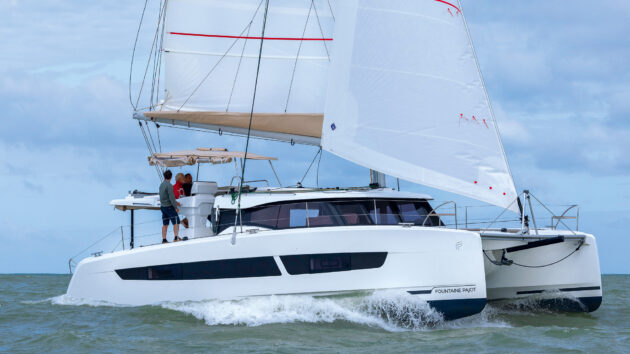
Sailing at pace with dry bows. The Fountaine Pajot 41 still packs in a lot of accommodation, both on the bridgedeck and in each hull. Photo: Jean-Marie Liot/Fountaine Pajot
On both yachts the first mainsail reef is single line, making it a simple operation to shorten sail, while reefs two and three need a Cunningham line to be passed through the luff cringle, which involves going up to the mast base. The argument is this simplifies handling overall by reducing the amount of rope that needs to be handled, as the purchase systems within single-line reefing set-ups makes the pennants for each one very long, with the effect magnified for deeper reefs.
Mainsail shape control is generally good, even though there is no vang, thanks to the wide traveller mounted on the aft end of the hard top. However, the high aspect jibs on both boats tend to twist off considerably when sheets are eased and there’s no obvious provision for outboard sheet leads. That probably doesn’t matter much in lighter airs when a Code 0 or asymmetric spinnaker is likely to be used when reaching, but it does mean that perfect sail trim can’t readily be achieved when reaching in the wind strengths I experienced during my test.
Nevertheless, the Fountaine Pajot’s boat speed topped out at 10.2 knots for the Fountaine Pajot 44 when reaching in a 27-knot puff, while maintaining averages of almost 9.5 knots with 20 knots of true wind 10° aft of the beam. Bearing away further to a true wind angle of 130° resulted in a drop of boat speed of only half a knot in these conditions, even though the apparent wind was down to less than 15 knots.
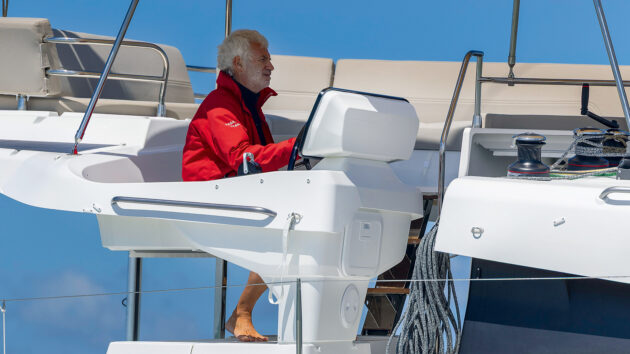
Rupert Holmes on the helm of the 41. Sail handling is carried out in a separate area forward, with room for two people to work. Photo: Jean-Marie Liot/Fountaine Pajot
Impressively, the averages when reaching for the Fountaine Pajot 41 were not much slower, with 8.9 to 9.2 knots recorded fairly consistently. And some of the speed differential can be explained by the Fountaine Pajot 44 having the upgrade from standard Dacron sails to an Ocean spec Hydranet fabric. This option is chosen by roughly 25% of owners and makes a tangible difference.
Sadly, I wasn’t able to try either boat in lighter airs. With its sub-10 tonne displacement and longer waterline, the Bahia 46 might on paper be expected to be faster in those conditions, but Code 0s that massively boost speed on a wide range of wind angles, from almost close hauled to broad reaching, weren’t routinely fitted to cruising boats a couple of decades ago and they make a huge difference to light airs speeds, even on a heavier boat.
While the Fountaine Pajot 44 is undeniably faster than the Fountaine Pajot 41, in cruising terms the difference between the two is modest, translating to maybe six or seven miles per 24 hours when on passage, although it’s worth remembering that the larger boat will tend to have a more comfortable motion at sea.
For those planning extensive and adventurous voyaging, a more important factor may be that the stability of a cruising catamaran increases exponentially, with the fourth power of the length of the boat. Despite the relatively small difference in overall length, the larger model can therefore be expected to offer as much as one-third greater resistance to capsize.
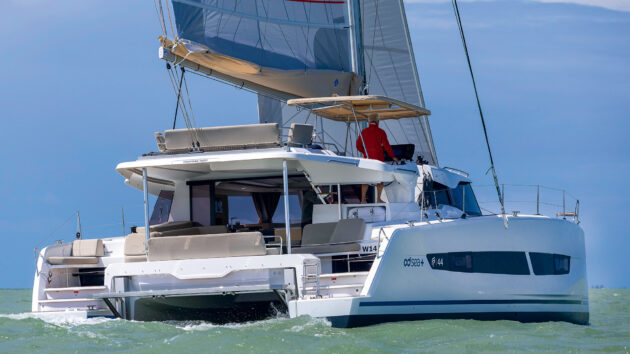
The FP 44 has a more comprehensive semi flybridge area with lots of seating and four sunbeds. Photo: Jean-Marie Liot/Fountaine Pajot
Flybridge differences
A cursory look around on deck won’t reveal many differences between the two models. Indeed, there are only two key visual clues, the most obvious being the semi-flybridge. The Fountaine Pajot 41 is the smallest ever Fountaine Pajot to have a semi-flybridge and only has a double sunbed, albeit with backrests that can be arranged to make sitting up comfortable.
By contrast, the Fountaine Pajot 44 has a much larger semi-flybridge than the Fountaine Pajot 41 with extensive seating as well as two sunbeds, making this an additional socialising area that could be useful, for instance, if sailing with teenagers and friends.
Even the Fountaine Pajot 41 is a big boat in many respects, with surprisingly large aft cabins and decent-sized forward cabins with peninsula beds. Arguably, the biggest downside in this respect is that the internal seating area is rather small, though the big aft cockpit area can be enclosed by canvas in inclement weather.
A drawback of four-cabin boats is also limited stowage space, but that’s not an issue for the three-cabin option that has considerable stowage in the owner’s suite.
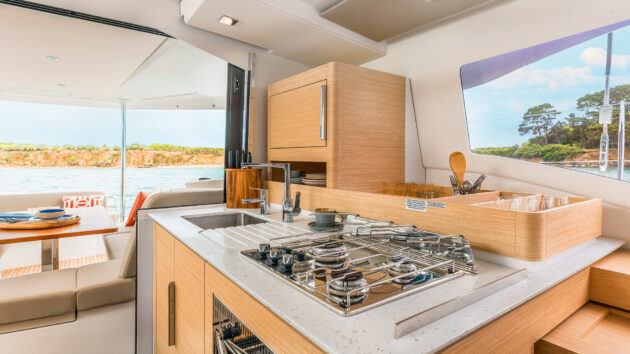
Worktops are made of recycled material that is easy to repair if damaged. Photo: Jean-Marie Liot/Fountaine Pajot
Many of these points also apply to the 44, though this is by no means simply a scaled-up 41. In particular, the larger model has more space in the middle of the hulls. As a result both cabins in the starboard hull are en suite, with separate shower stalls. By contrast, the Fountaine Pajot 41 has a choice of compact en suites, or larger shared facilities with a separate entrance from the corridor in the starboard hull.
The port hull of the 41 can be fitted out in two different ways – either as a mirror image of the two-cabin arrangement in the starboard hull, or as an owner’s suite. This has the sleeping area aft, a capacious heads area forward, plus a desk/dressing table amidships and a huge amount of stowage. A further option for the Fountaine Pajot 44 is to have a flexible forward workshop/storage area that could also be fitted out as a large dressing room if required.
Guest cabin stowage is not particularly generous on either boat, but there’s a massive amount of stowage space in the master hull of both boats. Equally, on-deck stowage is excellent, particularly if the optional skipper/children’s cabins right forward are not specified.
For those wanting to spend longer periods on board, the 41 has an option for a 3kg capacity washer-dryer in the owner’s hull, whereas the 44 has space for a full-size 7kg load unit with access from the corridor in the starboard hull.
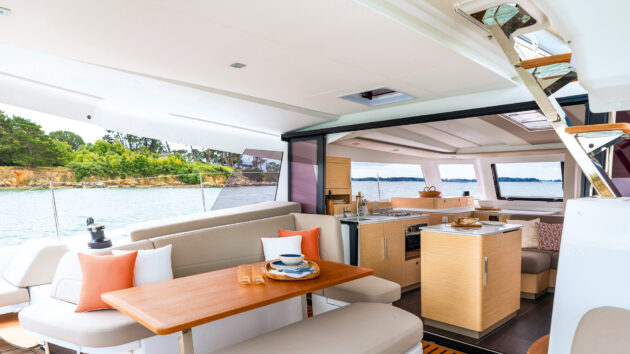
Island unit improves circulation and allows more people to prepare food etc in the galley. Photo: Jean-Marie Liot/Fountaine Pajot
The internal saloon can be ordered with a low coffee table or a larger raised dining table that allows for indoor eating. Both boats have an opening window in the front of the coachroof that improves natural ventilation and allows direct communication with the foredeck lounging area. The saloon also has a central overhead panel allowing you to view the sail trim, but doesn’t have so much overhead glazing that solar gain is excessive on either boat.
A much larger opening between the saloon and aft cockpit allows for a new galley format that includes a central island unit instead of L-shaped worktops. This works well, and gives better circulation of people, while also allowing more hands to easily work in the galley. Both boats share this layout, though the Fountaine Pajot 44 has a little more space and significantly improved refrigeration. There’s also good stowage for dry goods in several large under-floor compartments and below the saloon seats.On the downside, there’s no dedicated indoor navigation/watch-keeping station.

Both test boats have internal saloons with a low coffee table, but a dining table can be fitted. Photo: Jean-Marie Liot/Fountaine Pajot
The woodwork looked good on my test boats, but there are veneered capping pieces and sharp corners that may not withstand repeated knocks and bumps without damage. The interior of lockers also have a more domestic feel to them, rather than a traditional boatbuilding approach using higher-quality materials.
Worktops are made of recycled material sourced from the interiors of end-of-life fridges and freezers. They can be recycled back into new worktops and are easy to repair if damaged as the material can be worked like wood. Scratches can therefore be sanded out and the surface polished to restore an as-new appearance.
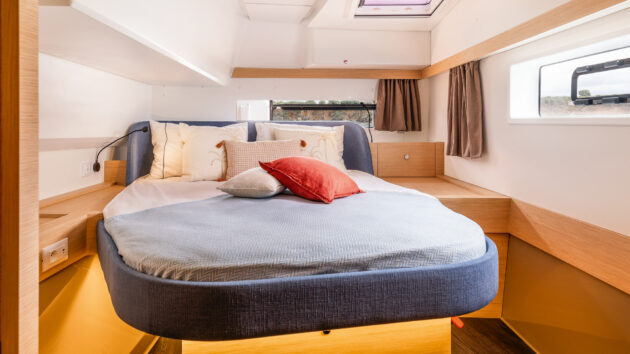
The master cabin of the FP 41. Photo: Jean-Marie Liot/Fountaine Pajot
Hybrid future
All models are available with conventional diesel engines and generators. However, the Fountaine Pajot group, which includes Dufour, is at the forefront of transitioning to hybrid technologies and has sold around 100 hybrid boats over the past two and a half years. This represents 15% of sales, a proportion that’s steadily climbing as more owners become satisfied that concepts and systems are well-proven.
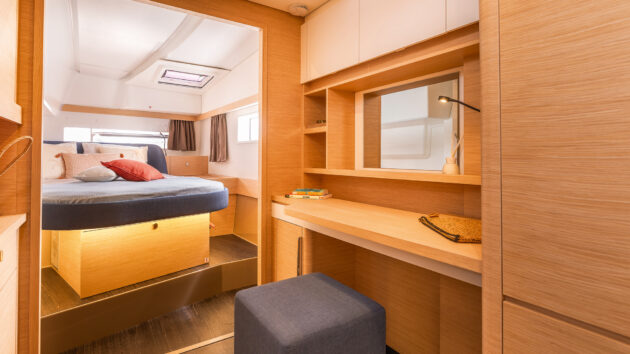
The aft cabins of both boats are impressively spacious, with generously-sized angled peninsula beds. Photo: Jean-Marie Liot/Fountaine Pajot
The Fountaine Pajot 44 I sailed was fitted with the ODSea+ Smart Electric hybrid propulsion. This encompasses propulsion, hydrogeneration, large solar arrays totalling around 2kW and huge battery banks that can also be used for domestic systems such as refrigeration and even air-conditioning.
It was developed in conjunction with fellow La Rochelle-based company Alternative Energies, which has been supplying systems to small ferries and work boats for 30 years and is now part of the Fountaine Pajot group.
Each hull has a 25kW pod drive motor, with a high voltage supply meaning that water cooling is not required – it’s a simple installation that requires little maintenance. The boat is also fitted with a soundproofed 24kW diesel generator that’s sized to allow for motoring at 8 knots in flat water, yet still puts an impressive 8kW into the battery bank. In addition, the hydrogenating facility under sail proved effective – at eight knots of boat speed we were charging at around 1.5kW on each engine.
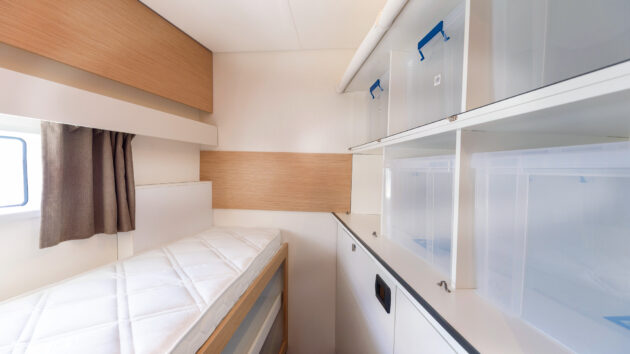
Optional storage/workshop area aboard the FP 44 . Photo: Jean-Marie Liot/Fountaine Pajot
Overall, it’s an impressive system that increases comfort, flexibility and autonomy, while reducing maintenance. In addition, a key benefit of electric propulsion is the large amount of torque that’s almost instantly available and therefore makes manoeuvring in tight corners easier.
Fountaine Pajot 41 specifications
LOA: 12.1m 39ft 8in
Beam: 6.92m 22ft 8in
Displacement: 12,700kg 28,000lb
Draught: 1.34m 4ft 5in
Mainsail: 65m2 700ft2
Genoa: 35m2 377ft2
Fresh water: 600lt 123gal
Fuel: 700lt 154gal
Prices ex VAT base: €404,000; approx as tested €545,000
Fountaine Pajot 44 specifications
LOA: 13.26m 43ft 5in
Beam: 7.44m 24ft 5in
Displacement: 15,200kg 33,510lb
Draught: 1.57m 4ft 6in
Mainsail: 75.5m2 812ft2
Headsail: 45m2 484ft2
Fresh water: 600lt 123gal
Fuel: 700lt 154gal
Prices ex VAT base: From €499,000; approx as tested €850,000
 If you enjoyed this….
If you enjoyed this….
Yachting World is the world’s leading magazine for bluewater cruisers and offshore sailors. Every month we have inspirational adventures and practical features to help you realise your sailing dreams.Build your knowledge with a subscription delivered to your door. See our latest offers and save at least 30% off the cover price.
Note: We may earn a commission when you buy through links on our site, at no extra cost to you. This doesn’t affect our editorial independence.
Verdict
Both the Fountaine Pajot 41 and 44 are refined designs with a lot of well thought out details that make life on board extremely comfortable and civilised. The Fountaine Pajot 41 represents a big step up from the Isla 40 it replaces, both in terms of accommodation and standard of finish. It also offers more space than the 20-year-old Bahia 46 I referred to, and a far more appealing bridgedeck layout. In other senses, these improvements come at a price: the 41 is roughly 25% heavier than the Bahia 46, yet has 16% less sail area. Similarly, while the 44 has 23% more sail area than the Bahia it’s more than 50% heavier. Nevertheless, both the 41 and the 44 remain capable of putting in decent passage times. While both are very similar boats in many respects, the 44 offers tangible advantages, such as the better en suite arrangements for the guest cabins, or improved flybridge area, that will sway the decision for some owners.




